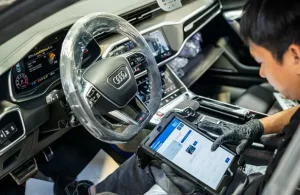The Rise of In-Car Connectivity and Its Implications

Over the past few years, we have seen a rapid rise in the number of cars equipped with in-car connectivity. From entertainment systems to navigation tools, these features have revolutionized the way we interact with our vehicles. In this article, we will explore the implications of this trend and how it is transforming the automotive industry.
What is In-Car Connectivity?
In-car connectivity refers to the integration of technology into a vehicle’s dashboard, allowing passengers to access a variety of services and features. This includes everything from Wi-Fi hotspots and streaming music to real-time traffic updates and remote vehicle monitoring. In-car connectivity is made possible through a combination of hardware and software, including touchscreens, sensors, and wireless communication technologies.
The Benefits of In-Car Connectivity
One of the primary benefits of in-car connectivity is increased safety. With real-time traffic updates and navigation tools, drivers can avoid congestion and accidents, reducing the risk of collisions. In-car connectivity also allows drivers to stay connected with the outside world without taking their eyes off the road. Voice-activated commands and hands-free calling ensure that drivers can stay focused on driving while staying in touch with friends and family.
In-car connectivity also offers a range of entertainment options for passengers. Streaming music and video services are now standard features in many new cars, providing a more enjoyable travel experience. Passengers can also stay connected to their devices, allowing them to stay productive while on the go.
The Implications of In-Car Connectivity

The rise of in-car connectivity has significant implications for the automotive industry. Firstly, it is creating new opportunities for innovation and product differentiation. As more cars become connected, manufacturers are competing to offer the most advanced features and services. This has led to a wave of investment in automotive technology, with companies like Tesla and Waymo leading the charge in autonomous driving technology.
In-car connectivity is also transforming the way we think about car ownership. As cars become more like mobile devices, we are seeing a shift towards subscription-based models that offer access to a range of features and services. This has the potential to disrupt the traditional car ownership model, with consumers opting for more flexible and personalized options.
The Future of In-Car Connectivity
As technology continues to advance, we can expect to see even more advanced in-car connectivity features in the future. From augmented reality displays to advanced voice assistants, the possibilities are endless. However, with these new features come new challenges, such as cybersecurity and data privacy concerns.
The rise of in-car connectivity has transformed the automotive industry, providing new opportunities for innovation and product differentiation. As we move towards a more connected future, we can expect to see even more advanced features and services, changing the way we think about car ownership and travel.





